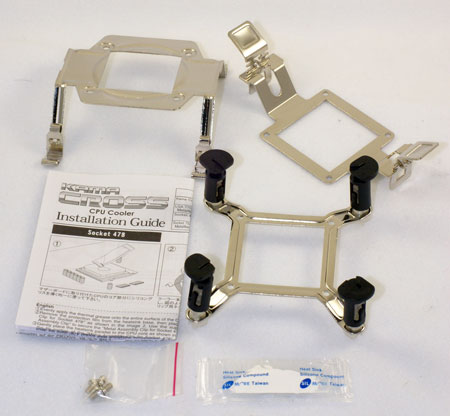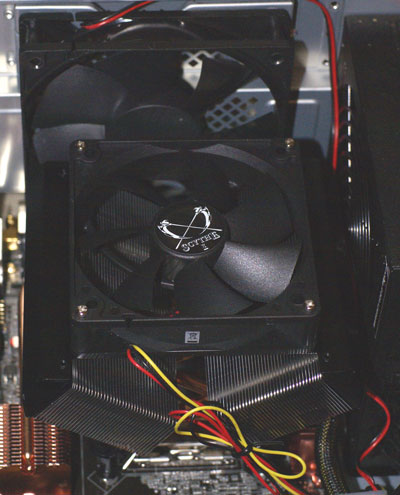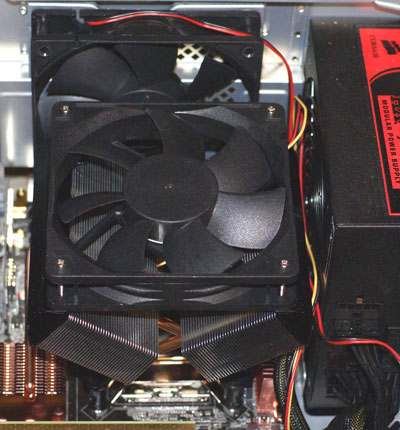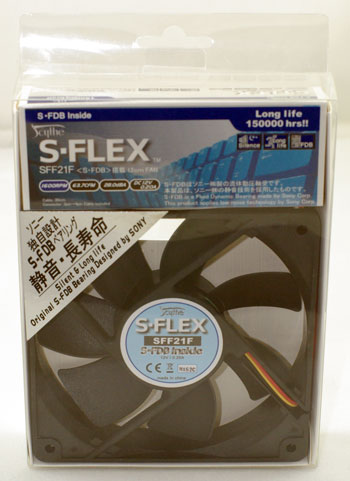New Mid-Priced Coolers from OCZ and Scythe: The Small and the X of It
by Wesley Fink on October 1, 2007 12:05 AM EST- Posted in
- Cases/Cooling/PSUs
Scythe Kama Cross
Scythe Co., Ltd. is a Japanese company located in Tokyo. Scythe started manufacturing and distributing products for the PC enthusiast in 2002. This included CPU cooling solutions like Scythe's first product, the Scythe Samurai. The Samurai developed quite a reputation among computer enthusiasts as an effective CPU cooler.
Scythe currently lists about a dozen air cooling solutions on their company website. These range from entry cooling solutions all the way to full cooling tower designs. Their current catalog includes the well-known Scythe Infinity, the Scythe Ninja Rev. B, and the Andy Samurai Master, which were all reviewed at AnandTech. There are also mid to low-end offerings such as the Scythe Katana 775 that was also reviewed at AnandTech.
Scythe always seems to have interesting designs for their coolers. You also find catchy and clever names, like the Kama Cross being reviewed here.

The text may be too small to read without a magnifying glass, but if there is something you want to know about the Kama Cross you will find it somewhere on the box. This is very typical of Scythe packaging.

Inside the box you will find the Kama Cross fully assembled except for the socket mounting plate. The design is truly unique, with an X configuration of 45° fin-cooled heatpipes. Scythe claims this unique design improves airflow to the motherboard compared to traditional top-mount fan designs.

The 100mm fan is pre-mounted, but Scythe also has provisions for easily mounting a 120mm fan. When you change fans you will find the fan holds the X together, and you will likely need to squeeze the sides of the cooler together to fit the holes on the second side. Once the fan is mounted the structure is light and very secure.

The stock 100mm fan does not completely cover the top of the cooler, but it does cover all the heatpipes in the X structure.

An optional 120mm fan, like the Scythe S-FLEX SFF21F, completely covers all the heatpipes in the design. Since Kama Cross is designed to support a 120mm fan, there is no real size savings using the included 100mm fan.
Specifications
The Kama Cross can mount on AMD 754/939/940/AM2 and both Intel Socket 775 and 478. Very few current coolers support Socket 478, so if you need a cooler for an older Intel 478 board this one will work.
The included fan is specified at a low 42.69 CFM at 12V. Thankfully, it is also claims a very low noise level of 22.0 dBA. It is very easy to increase airflow by mounting a 120mm fan in place of the stock 100mm. With many very low noise 120mm options, it is possible to increase airflow dramatically while keeping noise levels low.

For these reasons the Kama Cross was also tested with the excellent Scythe S-FLEX SFF21F. A favorite in past reviews, the S-FLEX uses a Sony Fluid Dynamic Bearing to decrease noise and increase fan life. The SFF21F increases air flow to 63.7 CFM at a specified noise level of just 28.0 dBA.
Installation
The Scythe Kama Cross is fully assembled except for the mounting plate. Attaching the plate is very easy - regardless of socket - and it just requires four screws and the mount is attached. You will not need to remove the motherboard in any of the sockets supported, as the Kama Cross will mount on the standard mounting cage.
For Intel 775, the Kama Cross mounts with the dreaded push clips. They work, the cooler is reasonably light, and they don't require removing the motherboard. However, Kama Cross overhangs the push clips on all sides and you may have quite a time reaching a hand in a mounted case to push all the clips home. In our typical mid-tower case the motherboard screws needed to be removed to slide the motherboard to the side so we could reach the back clips. Obviously, cooler mount designers should actually mount the cooler in typical cases before finalizing the design. Clips mount fine on a lab bench, but they cannot always be reached in real-life cases.
Scythe Co., Ltd. is a Japanese company located in Tokyo. Scythe started manufacturing and distributing products for the PC enthusiast in 2002. This included CPU cooling solutions like Scythe's first product, the Scythe Samurai. The Samurai developed quite a reputation among computer enthusiasts as an effective CPU cooler.
Scythe currently lists about a dozen air cooling solutions on their company website. These range from entry cooling solutions all the way to full cooling tower designs. Their current catalog includes the well-known Scythe Infinity, the Scythe Ninja Rev. B, and the Andy Samurai Master, which were all reviewed at AnandTech. There are also mid to low-end offerings such as the Scythe Katana 775 that was also reviewed at AnandTech.
Scythe always seems to have interesting designs for their coolers. You also find catchy and clever names, like the Kama Cross being reviewed here.

The text may be too small to read without a magnifying glass, but if there is something you want to know about the Kama Cross you will find it somewhere on the box. This is very typical of Scythe packaging.

Inside the box you will find the Kama Cross fully assembled except for the socket mounting plate. The design is truly unique, with an X configuration of 45° fin-cooled heatpipes. Scythe claims this unique design improves airflow to the motherboard compared to traditional top-mount fan designs.

The 100mm fan is pre-mounted, but Scythe also has provisions for easily mounting a 120mm fan. When you change fans you will find the fan holds the X together, and you will likely need to squeeze the sides of the cooler together to fit the holes on the second side. Once the fan is mounted the structure is light and very secure.

The stock 100mm fan does not completely cover the top of the cooler, but it does cover all the heatpipes in the X structure.

An optional 120mm fan, like the Scythe S-FLEX SFF21F, completely covers all the heatpipes in the design. Since Kama Cross is designed to support a 120mm fan, there is no real size savings using the included 100mm fan.
Specifications
The Kama Cross can mount on AMD 754/939/940/AM2 and both Intel Socket 775 and 478. Very few current coolers support Socket 478, so if you need a cooler for an older Intel 478 board this one will work.
| Scythe Kama Cross Specifications | |
| Dimensions | 140(W) x 120(D) x 132mm(H) |
| Weight | 530g (18.7 ounces) |
| Material | Copper heatpipes and aluminum fins |
| Configuration | 6 copper heatpipes in X configuration |
| Scythe 100mm Fan Specifications | |
| Fan Size | 100mm x 100mm x 25mm |
| Fan Type | Sleeve Bearing |
| Maximum Fan Speed | 1500 RPM |
| Maximum Noise Level | 22.0 dBA |
| Maximum Airflow | 42.69 CFM |
The included fan is specified at a low 42.69 CFM at 12V. Thankfully, it is also claims a very low noise level of 22.0 dBA. It is very easy to increase airflow by mounting a 120mm fan in place of the stock 100mm. With many very low noise 120mm options, it is possible to increase airflow dramatically while keeping noise levels low.

For these reasons the Kama Cross was also tested with the excellent Scythe S-FLEX SFF21F. A favorite in past reviews, the S-FLEX uses a Sony Fluid Dynamic Bearing to decrease noise and increase fan life. The SFF21F increases air flow to 63.7 CFM at a specified noise level of just 28.0 dBA.
Installation
The Scythe Kama Cross is fully assembled except for the mounting plate. Attaching the plate is very easy - regardless of socket - and it just requires four screws and the mount is attached. You will not need to remove the motherboard in any of the sockets supported, as the Kama Cross will mount on the standard mounting cage.
For Intel 775, the Kama Cross mounts with the dreaded push clips. They work, the cooler is reasonably light, and they don't require removing the motherboard. However, Kama Cross overhangs the push clips on all sides and you may have quite a time reaching a hand in a mounted case to push all the clips home. In our typical mid-tower case the motherboard screws needed to be removed to slide the motherboard to the side so we could reach the back clips. Obviously, cooler mount designers should actually mount the cooler in typical cases before finalizing the design. Clips mount fine on a lab bench, but they cannot always be reached in real-life cases.










22 Comments
View All Comments
Wesley Fink - Monday, October 1, 2007 - link
There is only one game available that may possibly perform better with a quad CPU. Our original thinking was that we would wait to move to quad testing until games are launched that give us a reason to buy a quad-core - somewhere in the future.However, the point is well-taken that quads do generate more heat than dual-core processors, so we will be doing a comparison in the next few weeks on a range of coolers tested on a quad-core CPU.
Acanthus - Monday, October 1, 2007 - link
That is fantastic, not all of us buy quads for gaming :DI have one for encoding.
strikeback03 - Tuesday, October 2, 2007 - link
same here, though it would be nice if Premiere would make use of more than one core.Spacecomber - Monday, October 1, 2007 - link
The graphs and the discussion of them seemed out of synch, especially on page 5. It's as if the chart being discussed didn't get included or the discussion is meant for another section.Anyway, I got confused at that point, just looked at the graphs, and drew my own conclusions from there on. ;-)
Wesley Fink - Monday, October 1, 2007 - link
The Intel Retail results on p.5 had not been updated for CoreTemp results. That has now been updated. Hopefully the commentary now matches the graphs.Spacecomber - Monday, October 1, 2007 - link
Yup, the previous bar for the intel heatsink said something like 41 deg, which left me scratching my head.The discussion of how the cooling scaled with higher clock speeds also seemed out of place on that page, since there is no graphical representation of that until you get to page 7. Perhaps you were just making those comments paranthetically on page 5, but I wasn't clear why it was being discussed where all the results being graphically presented were for default clock speeds.
FrankThoughts - Monday, October 1, 2007 - link
...that took one look at the Scythe "I'm an X! Isn't that AWESOME!" design and immediately figured performance was going to suck? Repeat after me: gimmicky cooler designs do NOT work well! Just look at the first image of the cooler: all the closely packed fins, lots of gap between the fan and the fins, and you can already guess that most of the air so going to go around the fins rather than through them.Maybe a plastic shroud around the HSF would have helped, but even then a large amount of air would just go through the center gap. This is one of those designs that looks nifty but has some bassackwards thermodynamic "theory" at its core.
strikeback03 - Tuesday, October 2, 2007 - link
I'm just surprised they let something out that sucks this bad. If the performance were at least a little better than stock some might buy it for the looks, but this performance is just embarrassing to Scythe.puffpio - Monday, October 1, 2007 - link
I agreeYou can immediately look at it and see that the air the fan blows is going to go AROUND the heat sink...basic fluid dynamics..path of least resistance
But also w/ the OCZ cooler, they cut out some heat sink fins to make a curve shape...so you loose thermal capacity and gain aesthetics?
Someone needs to design an enthusiast heat sink and fan that consulted a thermal and aerodynamic engineer...perhaps tapping into the skill set of people who design car radiators..
KazenoKoe - Wednesday, October 3, 2007 - link
I would like to know how the Scythe cooler performs with 2 smaller fans, one for each heatsink, instead of one fan at an odd angle.